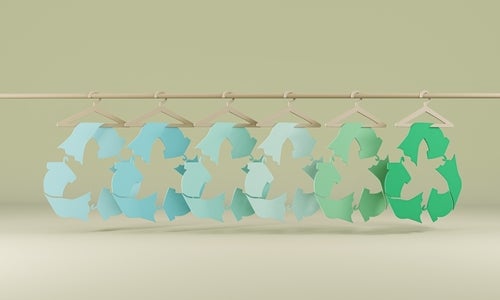
The WRAP report, which was published today (7 October) to coincide with World Circular Textiles Day, reveals the longevity of a range of clothing items has already increased since 2013, however there remains more opportunities for fashion brands and retailers to increase the sustainability and circularity of clothing.
The report, which is based on a survey of more than 6,000 UK adults and represents 45,000 items of clothing, shows changes over the last eight years in terms of how long consumers retain clothes, and how the openness to new ways of clothes ‘shopping’ could significantly reduce the environmental cost of clothing.
The UK’s wardrobes hold 1.6 billion items of unworn clothes, however the report found consumers are open to new ways of shopping and while many already buy and sell pre-loved clothes, more are open to alternatives schemes to ‘buy new’ shopping such as subscriptions, preloved and rental.
WRAP suggests new ways for fashion brands, retailers to design for circularity
WRAP believes, the report shows there is a prime opportunity for fashion brands and retailers to provide alternative clothing models like rental subscriptions, and for savvy sellers and buyers to save money, make a bit of cash and grab a bargain.
The report states there are opportunities for brands and retailers to reduce the impact clothing has on the environment by designing for circularity in key product categories. It says the findings support the
need for changes in design, but considerations need to be made to understand how products can be designed for circularity.
WRAP director collaboration and change, Catherine David explains: “The clothing and textiles sector has the fourth largest environmental impact on the planet and that’s why WRAP is working with the UK’s biggest retailers and brands to address this through the ambitious targets of Textiles 2030. Many people are already buying and selling pre-loved clothing, but our study shows the huge financial and environmental opportunity that is unworn in all our wardrobes.”

US Tariffs are shifting - will you react or anticipate?
Don’t let policy changes catch you off guard. Stay proactive with real-time data and expert analysis.
By GlobalDataShe continues: “Textiles 2030 signatories are already beginning to introduce resale and rental business models, but these alongside repair models must become widespread if the fashion industry is to begin to achieve the reductions in greenhouse gas emissions necessary to limit global warming to 1.5 degrees.”
WRAP explains that by understanding the predicted longevity of different clothing categories, the factors that effect this, and the reasons for not wearing, Textiles 2030 can support fashion brands and retailers to make design decisions that will extend the life of clothing.
The report adds that once fashion brands and retailers understand customers’ issues and pain points it will help to develop the opportunities.
It is also essential to recognise there is still significant scope to support and encourage consumers to care for clothing (so they last longer) through improved care and repair.
The report shows that between 2013 and 2021, the predicted length of time people in the UK kept a range of clothes increased.
For example, today, non-padded coats and jackets have the longest lifespans at more than six years apiece, while underwear and bras have the briefest at just 2.7 and 2.6 years respectively.
Jeans are now kept for an average of 4 years, compared to just 3 years in 2013. Dresses for 4.6 years compared to 3.8, and T-shirts (polo/jersey tops) now hold favour for 4 years, up from 3.3 years.
Furthermore, when consumers buy preloved and second-hand vintage, they tend to keep these items longer than those purchased new. Nearly a year and a half longer at 5.4 years for vintage and preloved clothes, compared to 4 years for off the peg.
Plus, if a consumer repairs an item of clothing, they will typically keep it for a further 1.3 years. But while wardrobes are storing more clothes for longer, a considerable number of items are underutilised.
WRAP’s key report findings
Purchase behaviour and clothing outlooks
- Almost half (45%) of UK citizens purchase clothing at least once a month (with around one in eight (13%) purchasing clothing weekly). Age is a key factor, with over four in five (81%) 18-24s purchasing clothing at least once a month. Clothing purchase frequency also increases with rising household income.
- Around one in four (23%) say they regularly buy clothing with the intention of using it for a short amount of time, highest among 18-34 men and 35-54 women.
- Just over half (54%) of UK citizens say they are happy to purchase second hand/vintage, compared to 46% who say they deserve better. Women are more comfortable with second hand than men; and those aged 65+ are least comfortable.
- Close to two in five (39%) say their wardrobes are disorganised and it can be difficult to know what is there, increasing among 18-34s (46%) and those with children (43%).
- Almost three in five UK citizens (59%) say they go to a lot of effort to maintain their clothes, compared to 41% who do not. A similar proportion (57%) say that they look for ways to repair damaged items. However, there is only a weak overlap between these groups, indicating that maintenance and repair are two discrete behaviours.



